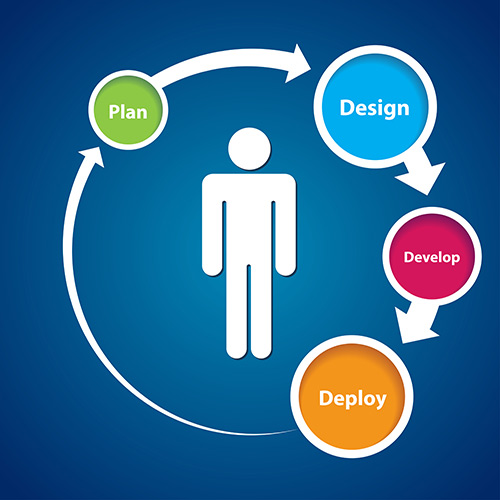The established design process at most marketing firms looks like this: Statement of work defines deliverables, contract establishes design revisions, and milestone payments are tied to design revisions or accepted designs. This process is a waterfall method and does not properly account for suspended features, new requests, different solutions, delays from stakeholders, etc. An agile design process is the key to account for changes, reduce stress on team members, and deliver award winning projects that make agencies and clients happy.
How does agile work for a designer?
As a designer, you are used to working in waterfall and it suits you very well, especially as a freelancer. The fundamental premise of agile methodology doesn’t sit very well with the design ideal. The concept of a working website or application as the primary goal of agile is very open ended and the visual nature of design can leave ‘working’ undefined since all team members may have a different definition. So how does a designer adapt to the agile method, satisfy all stakeholders and deliver professional level design?
Talk to the project manager, scrum master and or product owner and establish ‘task one,’ a milestone to define research. Before the agile sprint starts it is recommended that the designer understands the user experience and visuals that the client wants for their users. Utilize client questionnaires and attend client meetings at the kickoff of a project to get a sense of what the client is looking for. This phase will not solve all the problems, but it should encourage a broader approach of understanding what the client wants their users to do, accomplish, and also understand what are the key performance indicators of the project. Proper communication is essential to understanding stakeholders visual expectations to prevent hold ups. The final look and feel will be determined by the kpi’s reaching the targeted levels determined by the client. Until you reach that level in agile the project is not done.
Be involved in sprint zero, this beginning phase of agile methodology helps define how the work will be completed. As a designer this is the time to raise any concerns you have about concepting and how design fits into the overall two week standard sprint where a working website or app is being delivered for a stakeholder to review. Depending on the size of the project and necessary requirements to begin the first Sprint Zero could take several months. Some actions involved in this phase may be gathering additional team members, user questionnaires, and other research to see if the established assumptions can be backed up.
Communication is key in agile. As a designer, you might be comfortable working on designs, presenting, and getting feedback. But getting out of your chair and talking to the developers is important. If you’re a freelancer who works remotely, make yourself available for morning meetings called stand ups. All features are defined by user stories. For instance, a story like “Get statuses from the database” is development focused and will lead to many problems. A story like “Display the status of the order,” will make sense to you as the designer because you will define a wireframe with a 6 column table. By talking to team members you will have a better understanding of how user stories drives all aspects of the process.
Your level of involvement should not depend on what part of the design team you are responsible for. A small team may have a designer executing visual and user experience roles at the same time. The visual designer, UX designer, and UI developers should be very clear which stories they need to complete and what that completion criteria looks like. Understand that the client may change their mind, but in agile this is expected. For instance, landing pages with A/B testing are a normal deliverable, but two landing page designs should not end the project. How are those landing pages performing? Another sprint will involve applying what was learned after the landing pages went up on the previous sprint. What did the client and marketers learn based off what they were measuring? Should the designer be building a different color CTA this sprint based off the KPI of signups to the system?
The visual design may not be accepted by the client in time to be ready for the developers. In agile, that’s fine! As the designer, your responsibility is to deliver visuals that all stakeholders will agree upon. Ensure that all marketers, designers and clients understand the difference between unacceptable sloppy work and a bootstrapped website with temporary graphics in place of real assets. Ensure stakeholders on the business side will be ok with that. Agile does not stress documentation, but all teams members should know the parameters of what are acceptable visual prototypes or working sites in a sprint before anything is shown to the client.
By taking these steps you will find that agile makes you a more actively involved designer who helps to define the product all the way to the end. Also it’s a rewarding experience seeing your design turned into reality right in front of you. It’s your chance to refine your design as it’s being built.

